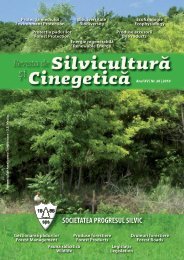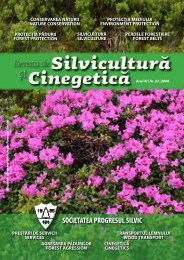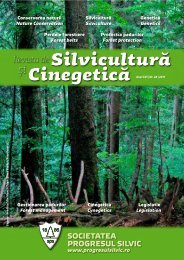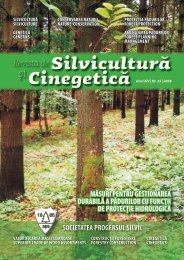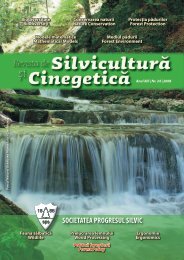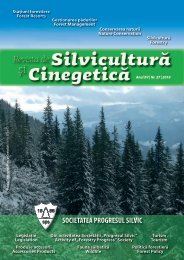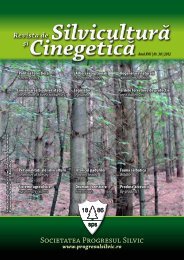Silviculture and Cinegetics Review - Societatea Progresul Silvic
Silviculture and Cinegetics Review - Societatea Progresul Silvic
Silviculture and Cinegetics Review - Societatea Progresul Silvic
Create successful ePaper yourself
Turn your PDF publications into a flip-book with our unique Google optimized e-Paper software.
FORESTRY POLICY SILVICULTURE AND CINEGETICS REVIEW XVII/30/2012<br />
5.000 <strong>and</strong> 1 : 2.000, provided by O.C.O.T.A. <strong>and</strong> after<br />
revising the aerospace maps.<br />
It should be noted that, compared to the plot division<br />
used starting with 1991 (applying Law 18) there were<br />
some cases of total inconsistency with the recent<br />
satellite images, which led us to not placing of certain<br />
curtains, although the reality in the field would have<br />
requested it.<br />
Based on existing soil maps in this study were adapted<br />
three groups of measures (GM) to install curtains,<br />
overlapping three types of soil: chestnut steppe soil,<br />
typical chernozem, cambic chernozem (or argillic<br />
chernozem).<br />
The species used for the afforestation of the three<br />
types of soil are: 60 Sc, 20 Vi.t, 20 Pd on chernozem,<br />
60 Gl, 20 Ul.t, 20 Sl on chestnut steppe soil, 60 St.<br />
br, 20 Pr, 20 Mc on cambic chernozem (or argillic<br />
chernozem).<br />
For deep chernozem the black locust is preferred<br />
because, even is exploited according to the forestry<br />
regime or cut out of low, it has a high capacity to<br />
regenerate so the role of the curtain is fulfilled even<br />
the first years after exploitation.<br />
The honey locust (glad) <strong>and</strong> the Turkestan elm are<br />
proposed for afforestation of soils where the substrate<br />
consists of chestnut steppe soil with a high content<br />
of calcium carbonate present even in the A horizon.<br />
The plantations on l<strong>and</strong>s with soils of cambic<br />
chernozem or argillic chernozem, situated in the<br />
grassl<strong>and</strong>s <strong>and</strong> the transition to forest zone will have<br />
as main species the grayish oak or the downy oak<br />
together with secondary mixed st<strong>and</strong> species (Pr, Te.a,<br />
Ar.t) <strong>and</strong> shrubs (Mc).<br />
The planting scheme shall be 2 x 1 m with stem<br />
cutting-back of seedlings after planting.<br />
The beating up (filling the gaps) are expected to be of<br />
about 20 % in the first year <strong>and</strong> of 10 % in the second<br />
year, <strong>and</strong> maintenance will consist of soil mobilization<br />
for 3 years for the black locust / honey locust curtains<br />
<strong>and</strong> of a minimum of 5 years for the oak ones.<br />
There were planned 2-3 weedings <strong>and</strong> 3 defoliators’<br />
control treatments.<br />
4. Implementation of protection forest<br />
belt for which the documentation was<br />
developed during 2005 - 2006<br />
In the case of both the forest belts for the protection of<br />
communication ways <strong>and</strong> the ones for the protection<br />
of fields, in order to relieve the planting effort the<br />
planting machines can be used as a measure balance<br />
the lack of labor force.<br />
The required seedlings can be produced locally, in the<br />
existing nurseries of the RNP-Romsilva forest districts<br />
but also by increasing the production capacity of the<br />
private nurseries that already exist.<br />
For the afforestation of areas for forest belt settlement<br />
<strong>and</strong> other compact areas in the region, in addition to<br />
the I.C.A.S. existing staff, the central authority in<br />
charged with forestry has certified individuals <strong>and</strong><br />
companies to develop technical documentation<br />
(SF,PE, etc).<br />
For the execution of the works of l<strong>and</strong> <strong>and</strong> soil<br />
preparation, planting, maintenance, pest control there<br />
are operators licensed by the ministry.<br />
Both in the present <strong>and</strong> in the future for a lot of the<br />
areas dedicated to the afforestation with protection<br />
belts, irrigation may be applicable.<br />
We consider there is now a chance that the National<br />
Program of Afforestation with Protective Forest Belts<br />
might be put into practice.<br />
At the time of this communication none of the<br />
seedlings planned in the 2005-2006 documentation<br />
was planted. The main cause of this failure as follows:<br />
the failure to identify <strong>and</strong> contact all owners or heirs<br />
for obtaining agreement to plant the forest belts.<br />
Together with the municipalities were drawn lists of<br />
1744 owners of the l<strong>and</strong> designated for forest belts for<br />
the protection of communication ways <strong>and</strong> lists of<br />
24800 owners for the field protection forest belts.<br />
With significant demographic changes experienced by<br />
the population of Romania in recent years (about 3.0<br />
million Romanians working or living abroad) the<br />
project of afforestation was blocked at this phase.<br />
In all the years since the project was initiated many<br />
interventions to local <strong>and</strong> central authorities, to<br />
legislative bodies (Romanian parliament), academy<br />
(A.S.A.S.) or to various interested non-governmental<br />
organizations (<strong>Progresul</strong> <strong>Silvic</strong>) were made, with<br />
suggestions of ways to overcome this blockage.<br />
At present, the hope that the National Program of<br />
Afforestation with Protective Forest Belts will take<br />
effect is renewed. This expectation is related to the<br />
fact that on December 31st, 2011 parliament has<br />
28



